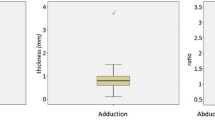Abstract
Purpose
To characterize the supraspinatus tendon thickness, subacromial space, and the relationship between tendon thickness and subacromial space to further elucidate the mechanisms of subacromial impingement syndrome.
Methods
In a single-blind cross-sectional study, subjects were recruited with subacromial impingement syndrome (n = 20) and asymptomatic controls (n = 20) matched for age, gender, and hand dominance. Ultrasound images were collected using a 4–12-MHz linear transducer in B-mode of the supraspinatus tendon in the transverse (short axis) and the anterior aspect of the subacromial space outlet. Using image callipers, measurements of tendon thickness were taken at 3 points along the tendon and averaged for a single thickness measure. The subacromial space outlet was measured via the acromiohumeral distance (AHD) defined by the inferior acromion and superior humeral head. The occupation ratio was calculated as the tendon thickness as a percentage of AHD.
Results
The subacromial impingement syndrome group had a significantly thicker tendon (mean difference = 0.6 mm, p = 0.048) and a greater tendon occupation ratio (mean difference = 7.5 %, p = 0.014) compared to matched controls. There were no AHD group differences.
Conclusions
The supraspinatus tendon was thicker and occupied a greater percentage of AHD, supporting an intrinsic mechanism. An extrinsic mechanism of tendon compression is theoretically supported, but future imaging studies need to confirm direct compression with elevation. Treatment to reduce tendon thickness may reduce symptoms, and surgical intervention to increase subacromial space may be considered if tendon compression can be verified.


Similar content being viewed by others
References
Azzoni R, Cabitza P (2004) Sonographic versus radiographic measurement of the subacromial space width. Chir Organ Mov 89:143–150
Azzoni R, Cabitza P, Parrini M (2004) Sonographic evaluation of subacromial space. Ultrasonics 42:683–687
Bretzke CA, Crass JR, Craig EV, Feinberg SB (1985) Ultrasonography of the rotator cuff. Normal and pathologic anatomy. Invest Radiol 20:311–315
Cholewinski JJ, Kusz DJ, Wojciechowski P et al (2008) Ultrasound measurement of rotator cuff thickness and acromio-humeral distance in the diagnosis of subacromial impingement syndrome of the shoulder. Knee Surg Sports Traumatol Arthrosc 16:408–414
Desmeules F, Minville L, Riederer B et al (2004) Acromio-humeral distance variation measured by ultrasonography and its association with the outcome of rehabilitation for shoulder impingement syndrome. Clin J Sport Med 14:197–205
Flatow EL, Soslowsky LJ, Ticker JB et al (1994) Excursion of the rotator cuff under the acromion. Patterns of subacromial contact. Am J Sports Med 22:779–788
Giphart JE, van der Meijden OA, Millett PJ (2012) The effects of arm elevation on the 3-dimensional acromiohumeral distance: a biplane fluoroscopy study with normative data. J Should Elbow Surg 21:1593–1600
Girometti R, De Candia A, Sbuelz M et al (2006) Supraspinatus tendon US morphology in basketball players: correlation with main pathologic models of secondary impingement syndrome in young overhead athletes. Preliminary report. Radiol Med (Torino) 111:42–52
Joensen J, Couppe C, Bjordal JM (2009) Increased palpation tenderness and muscle strength deficit in the prediction of tendon hypertrophy in symptomatic unilateral shoulder tendinopathy: an ultrasonographic study. Physiotherapy 95:83–93
Juul-Kristensen B, Bojsen-Moller F, Holst E, Ekdahl C (2000) Comparison of muscle sizes and moment arms of two rotator cuff muscles measured by ultrasonography and magnetic resonance imaging. Eur J Ultrasound 11:161–173
Kalra N, Seitz AL, Boardman ND III, Michener LA (2010) Effect of posture on acromiohumeral distance with arm elevation in subjects with and without rotator cuff disease using ultrasonography. J Orthop Sports Phys Ther 40:633–640
Leggin BG, Michener LA, Shaffer MA et al (2006) The Penn shoulder score: reliability and validity. J Orthop Sports Phys Ther 36:138–151
Leong HT, Tsui S, Ying M et al (2012) Ultrasound measurements on acromiohumeral distance and supraspinatus tendon thickness: test-retest reliability and correlations with shoulder rotational strengths. J Sci Med Sport 15:284–291
Malanga GA, Chu SK, Ramirez Del TJ et al (2012) Sonographic evaluation of supraspinatus cross-sectional area in collegiate baseball players. PM R 4:488–492
Michener LA, McClure PW, Karduna AR (2003) Anatomical and biomechanical mechanisms of subacromial impingement syndrome. Clin Biomech (Bristol, Avon) 18:369–379
Michener LA, Walsworth MK, Doukas WC, Murphy KP (2009) Reliability and diagnostic accuracy of 5 physical examination tests and combination of tests for subacromial impingement. Arch Phys Med Rehabil 90:1898–1903
Neer CS (1983) Impingement lesions. Clin Orthop Relat Res 3(173):70–77
Pijls BG, Kok FP, Penning LI et al (2010) Reliability study of the sonographic measurement of the acromiohumeral distance in symptomatic patients. J Clin Ultrasound 38:128–134
Seitz AL, McClure PW, Finucane S et al (2012) The scapular assistance test results in changes in scapular position and subacromial space but not rotator cuff strength in subacromial impingement. J Orthop Sports Phys Ther 42:400–412
Seitz AL, Michener LA (2011) Ultrasonographic measures of subacromial space in patients with rotator cuff disease: a systematic review. J Clin Ultrasound 39:146–154
Thompson MD, Landin D, Page PA (2011) Dynamic acromiohumeral interval changes in baseball players during scaption exercises. J Shoulder Elbow Surg 20:251–258
Wallny T, Wagner UA, Prange S et al (1999) Evaluation of chronic tears of the rotator cuff by ultrasound. A new index. J Bone Joint Surg Br 81:675–678
Wang HK, Lin JJ, Pan SL, Wang TG (2005) Sonographic evaluations in elite college baseball athletes. Scand J Med Sci Sports 15:29–35
Conflict of interest
The authors declare that they have no conflict of interest.
Author information
Authors and Affiliations
Corresponding author
Rights and permissions
About this article
Cite this article
Michener, L.A., Subasi Yesilyaprak, S.S., Seitz, A.L. et al. Supraspinatus tendon and subacromial space parameters measured on ultrasonographic imaging in subacromial impingement syndrome. Knee Surg Sports Traumatol Arthrosc 23, 363–369 (2015). https://doi.org/10.1007/s00167-013-2542-8
Received:
Accepted:
Published:
Issue Date:
DOI: https://doi.org/10.1007/s00167-013-2542-8




